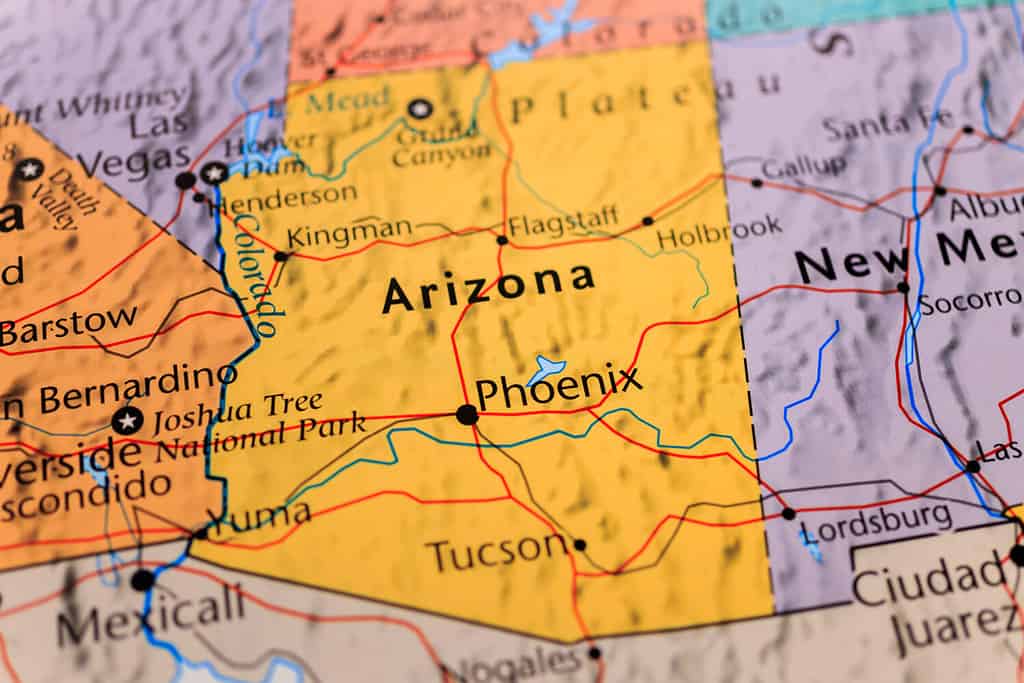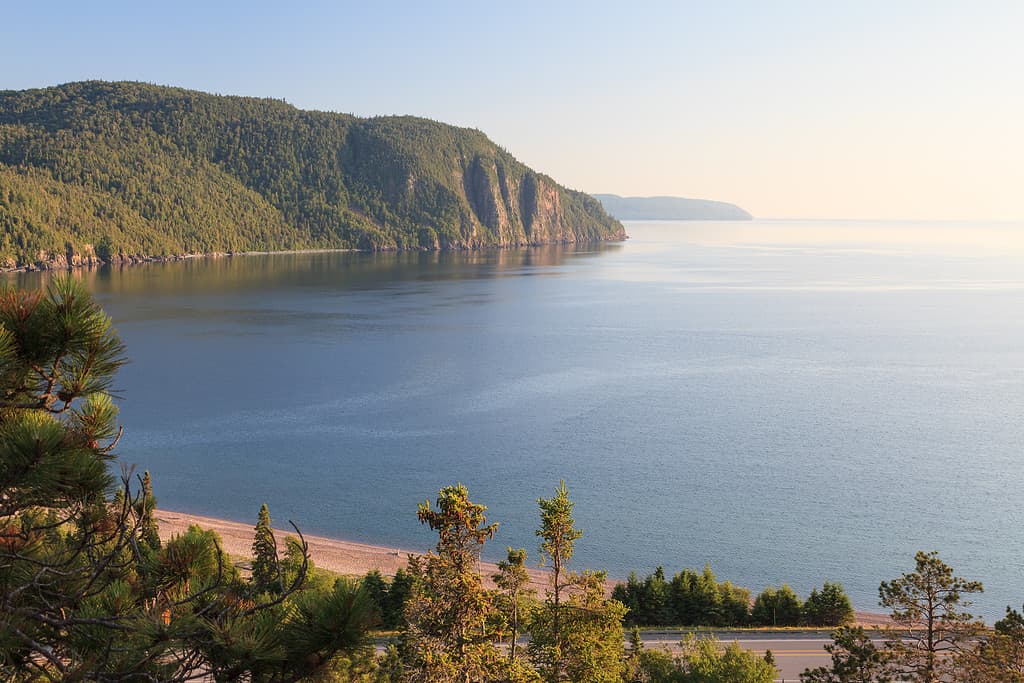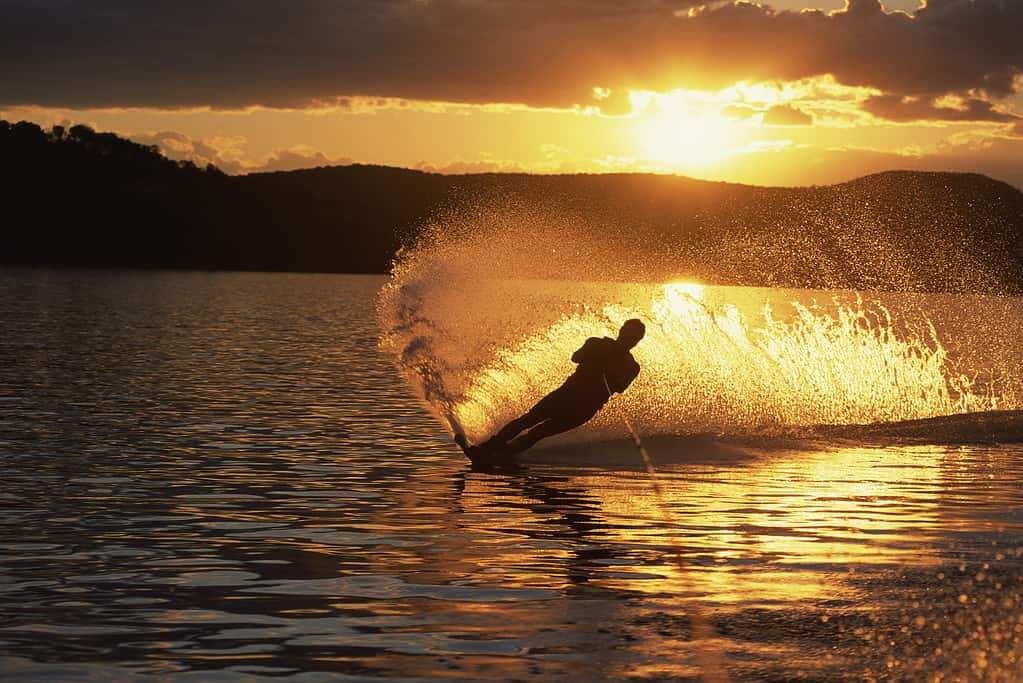There’s no doubt that Lake Pleasant lives up to its name! This Arizona lake is a jewel in the desert surrounded by an expansive regional park offering outdoor activities limited only by your imagination.
Situated in the City of Peoria in Arizona, just 35 miles north of downtown Phoenix, Lake Pleasant is the only water-based park in Maricopa County. Created in 1927 by the Carl Pleasant Dam, the reservoir was expanded in 1994 and tripled in size. Thanks to its proximity to Arizona’s capital city, Lake Pleasant is a scenic oasis for more than one million water enthusiasts and nature lovers visiting every year.
Size of Lake Pleasant
Lake Pleasant is 7 miles long and about 4 miles wide at its widest point in the northern section of the lake.
As the largest lake in the Phoenix and Scottsdale area, Lake Pleasant’s stunning waters cover 10,000 acres of water surface, or 16 square miles. The lake boasts innumerable winding coves and inlets, giving it an impressive 116 miles of shoreline. This doesn’t count the shoreline of several charming little islands scattered throughout the water. Its average depth is 70 feet, though its deepest point near the New Waddell Dam plunges to a depth of 260 feet.
Where Is Lake Pleasant?

Lake Pleasant is located just an hour north of Arizona’s capital city of Phoenix.
©Alexander Lukatskiy/Shutterstock.com
Lake Pleasant sits within the borders of the City of Peoria, straddling the border of Maricopa and Yavapai Counties. That’s about an hour’s driving distance northwest from Phoenix, AZ. The lake is located right in the middle of the state, making it equally accessible to all Arizona residents. It is about 400 miles due east from Los Angeles, CA, and around 300 miles southeast from Las Vegas, NV.
Lake Pleasant is surrounded by the 25,000-acre Lake Pleasant Regional Park. The park is a natural expanse of mountainous desert landscape offering hiking, picnicking, wildlife watching, and many more outdoor activities.
How Long Would It Take to Swim Across Lake Pleasant?

Lake Pleasant lives up to its name. It is a wonderful retreat from the city.
©iStock.com/Jearlwebb
Since Lake Pleasant is a man-made lake, the landscape below the water fluctuates unpredictably. Swimmers may not realize that they could be in 3 feet of water and after taking only a few steps they can no longer touch the bottom. Another consideration is that water temperature varies depending on the depth of the water. Swimming near the dam where the depth is 260 feet could be extremely cold as opposed to summer surface temperatures of between 75-80 degrees Fahrenheit.
Lake Pleasant is a boater’s dream come true, so swimmers need to be conscious of the danger of boats. Wearing a life jacket is recommended for anyone out in the water, whether swimming or lounging on an inner tube in one of the lake’s many coves.
A strong swimmer progressing at 2 miles per hour would need 3.5 hours to cross at its widest point.
How the Size of Lake Pleasant Compares to Other Lakes

Lake Superior dwarfs Arizona’s lakes, but it doesn’t benefit from warm summer water temperatures.
©gqxue/iStock via Getty Images
Water levels on Lake Pleasant vary considerably throughout the year as water is pumped in or drained out. Because the reservoir’s water level can fluctuate as much as 125 feet during the course of one year, Maricopa County created an interactive map allowing visitors to check the approximate shoreline of the lake at the time of their outing.
Although Lake Pleasant is the largest lake in the Phoenix area, it is small compared to Arizona’s largest lakes. Another man-made water destination, Lake Powell is the second-largest reservoir in the United States at 161,390 acres, and Arizona’s largest lake. While Lake Powell beats Lake Pleasant by about 148,000 acres, all of Arizona’s lakes are dwarfed by the country’s largest lake. Lake Superior, as its name suggests, covers an unbelievable surface area of 31,700 square miles, or 20,288,000 acres, in the northern United States.
Learn where Lake Pleasant ranks against Arizona’s biggest lakes.
Things to Do at Lake Pleasant

Waterskiing is one of the lake’s most popular attractions.
©© Getty Images/Stockbyte via Getty Images
The better question is what can’t you do at Lake Pleasant! The lake and the surrounding Lake Pleasant Regional Park offer the ideal destination for hikers, swimmers, boaters, campers, picnickers, and wildlife enthusiasts.
Watersports
Lake Pleasant is open 24 hours a day, 365 days a year. Visitors with speed boats, jet skis, and sailboats can access a 10-lane and 4-lane boat ramp through the main entrance of the lake. The ramps are near a parking lot with room for 700 vehicles. The two major marinas at Lake Pleasant offer a place for boaters to refuel and park their boats in a slip. They also provide a place where visitors can rent houseboats, pontoon boats, jet skis, speed boats, fishing boats, and kayaks. Scorpion Bay Marina is a floating community boasting a general store with a deli and a dockside restaurant. Pleasant Harbor Marina and RV Resort is a full-service marina with a dockside bar and grille and a Five-Star RV Resort with close to 300 spaces.
Camping
Campers are in for a treat when choosing between 148 sites split between Lake Pleasant Regional Park’s two campgrounds. The Desert Tortoise Campground offers a mix of developed, semi-developed, and tent-only sites. The Roadrunner Campground’s sites are all developed, meaning the site has water, electricity, a dump station, a covered ramada, a picnic table, a barbecue grill, and a fire ring.
Hiking
Lake Pleasant Regional Park is a hiker’s paradise. With 18.84 miles of trails for pedestrian use only, it is a safe activity for families with children of all ages. Hikers can choose trails of varying lengths from 0.5 miles to 4.4 miles. The Pipeline Canyon Trail boasts a floating bridge to allow access during high water levels. It is the designated hiking trail at the park. The Discovery Center Trail is your best bet when staying at the Roadrunner Campground. It connects the campground to the Discovery Center only a half-mile walk away. The Roadrunner Trail overlooks the lake and takes hikers on a 1.5-mile exploration of the beautiful Sonoran Desert landscape. It links the Discovery Center with picnic areas and the boat ramp.
Education
Kids and adults alike enjoy visiting the Lake Pleasant Discovery Center. It features a remarkable display of interpretive exhibits that whisk you back in time. Experience how the native inhabitants and early settlers lived and worked in the area before the reservoir was created. The center has wildlife display animals as well as an outdoor area where kids can climb on a giant eagle hunting a fish. There is a viewing platform where you can take in the sparkling lake, the surrounding natural desert beauty, and the New Waddell Dam. Before you go, stop at the center’s gift shop to pick up a souvenir to remember your trip to the lake.
Fishing
Lake Pleasant is one of the top fishing lakes in Arizona for a wide variety of fish species. At least 15 species of fish including striped bass, largemouth bass, white bass, catfish, crappie, and numerous other fish species call the lake home. Rangers never meant to stock the lake with striped bass yet they have come to thrive to such an extent they are now the most abundant and sought-after game fish. They likely made their way into the lake through the aqueduct. Anglers have caught striped bass weighing more than 25 pounds. In fact, surveys found flathead catfish weighing in at more than 45 pounds!
Scuba Diving
Scuba diving is another popular sport people enjoy at the lake. Lake Pleasant is well-known as having some of the best inland scuba diving in all the western states! Scuba divers can explore the lake’s deep underwater canyons and dive 260 feet down to view the New Waddell Dam. While the water requires a drysuit in winter months, water temperatures are high enough during the summer for divers to skip a wetsuit altogether.
Stargazing
Far enough away from city lights against the backdrop of the serenity of the lake, Lake Pleasant Regional Park is an ideal venue for stargazing. Stargazing at the lake starts at 7 p.m. at the Discovery Center. Observe planets like Jupiter and Saturn and the multitude of stars the clear skies put on display. Forget to pack your telescope? Not to worry, as telescopes are provided for stargazers of all ages.
Annual Events at Lake Pleasant in Arizona
Festivals and events at the lake are popular attractions year-round and offer even more options for visitors.
The Bill Luke Bass Days is a festival in March featuring carnival rides, wildlife exhibits, vendors, food, and live music day and night at the Lake Pleasant Marina with cash prizes for big fish caught every hour.
A full day of paddle sports awaits visitors to The Lake Pleasant Paddle Fest, a family event held in April. Test out different paddle crafts as you listen to live music. Don’t forget to grab a bite to eat after a long day in the water.
The July 3 Fireworks Celebration in July has live music, food, and drink vendors, as well as inflatable water slides and bounce houses for the kids.
Wildlife Around Lake Pleasant

Saguaro cacti dot the landscape that is home to hundreds of species of plants and animals.
©Norm Lane/Shutterstock.com
Wildlife enthusiasts are in for a thrill as they encounter animals thriving in their natural habitats. Exploring the vast network of hiking trails throughout Lake Pleasant Regional Park is your ticket to enter the natural world inhabited by an exciting variety of plants and animals.
Birds
The park boasts 294 bird species that include migratory waterfowl as well as permanent desert dwellers. Peregrine falcons, golden eagles, and nesting bald eagles are the resident celebrities for bird watchers. Hikers, though, will also enjoy spotting ladder-backed woodpeckers, Costa’s hummingbirds, and many other common desert species. Flocks of American white and brown pelicans stop by the lake in late summer during migration.
Mammals
Lake Pleasant is an oasis for animals living in the dry desert environment. This makes it the perfect setting to encounter the region’s diverse animal life. You can spot mule deer getting a drink at the lake during the summer months. If you are quick, you might spy a Harris antelope squirrel, black-tailed jackrabbit, or desert cottontail speeding through the brush trying to evade a hungry coyote or bird of prey. Javelina, or collared peccary, travel in groups of up to 20 members and tend to avoid humans. If you do come across the 60-pound mammals, make loud noises to scare them off as they have bitten dogs.
Reptiles/Amphibians
Watch your step if you hike in the cooler times of day as the park is home to several species of poisonous rattlesnakes. Most of the wildlife around the lake is harmless, though. Keep an eye out for a Sonoran desert tortoise as it forages for vegetation and the lowland leopard toad croaking along the water’s edge.
Plants
The park’s vegetation is typical of the desertscrub plant communities in the Sonoran Desert. This includes small-leaved trees, spiny and aromatic woody plants like the blue palo verde (Parkinsonia florida), and saguaro cactus (Carnegiea gigantea). Springtime guarantees hikers a feast for the senses when the rain brings super blooms of wildflowers. Enjoy Mexican gold poppy (Eschscholzia californica ssp. mexicana), violet-blue desert lupine (Lupinus shockleyi), yellow brittlebush (Encelia farinosa) and desert marigolds (Baileya multiradiata), and red firecracker penstemon (Penstemon eatonii). Poppy fans want to head to the Pipeline Canyon Trail as it has the heaviest concentration of the golden flowers.
Invasive species
Surviving a desert environment is challenging for all species of plants and animals, but competition with non-native wildlife makes life even tougher. These invasive species may have been introduced on purpose or on accident. Quagga mussels have infested a host of important waters in Arizona and other western states. Often introduced from the aquarium trade, invasive aquatic plants like elephant grass cause serious ecological impacts on the lake.
Fun Facts About Lake Pleasant

Burros are year-long residents around Lake Pleasant.
©Tom Tietz/Shutterstock.com
Waddell Dam
Did you know that the original Waddell Dam was the largest agricultural dam in the world at the time of its construction in 1927? This privately built dam was 76 feet high and 2,160 feet long and created the upper portion of a much smaller Lake Pleasant. In 1993, the New Waddell Dam was created, increasing the size of Lake Pleasant from its original 3,706 acres to its current size of 10,000 acres and submerging the original dam. Now the old dam is a treat for scuba divers to explore and wildlife to use as a home.
Annual Closures to Protect Bald Eagles
Lake Pleasant closes the Agua Fria arm of the lake every year from December 15 through June 15 to protect nesting bald eagle habitat from disturbances that can impact the success of these once-endangered, majestic birds. It is one of the few select areas within Arizona designated as a potential breeding site for bald eagles. Humans must stay away to protect nesting eagles, so Maricopa County Parks and Recreation offers a 24-hour Live Bald Eagle Cam. You can experience the magic of an eagle hatching and growing as its parents care for their young.
Federal Burro Herd Management Area
Lake Pleasant Regional Park lies within a federal burro herd management area. You are likely to see a few of the 250 protected burros that graze around the lake year-round. One of the best ways to see these entertaining equines is by hiking the 3.2-mile Wild Burro Trail.
H2 Whoa
Lake Pleasant is home to H2 Whoa! Guinness World Records has recognized this unique attraction as the world’s tallest floating waterslide.
The photo featured at the top of this post is © Roger Siljander/Shutterstock.com
Thank you for reading! Have some feedback for us? Contact the AZ Animals editorial team.






